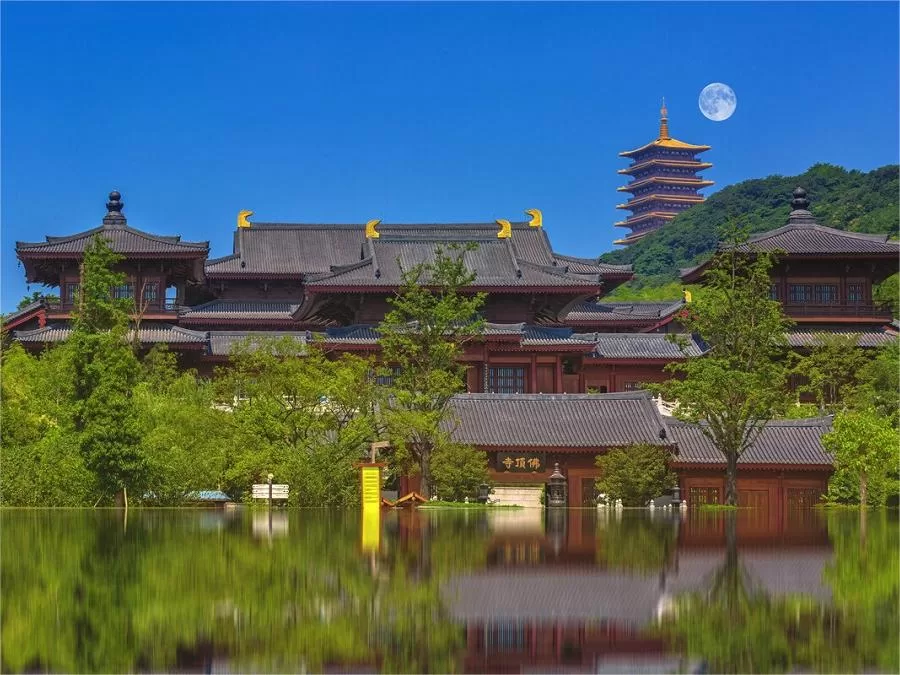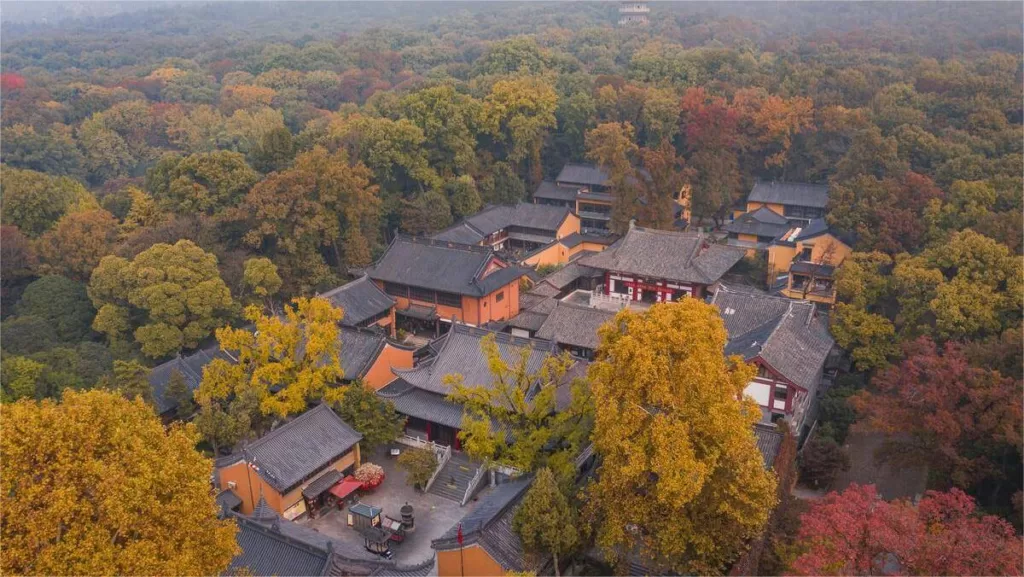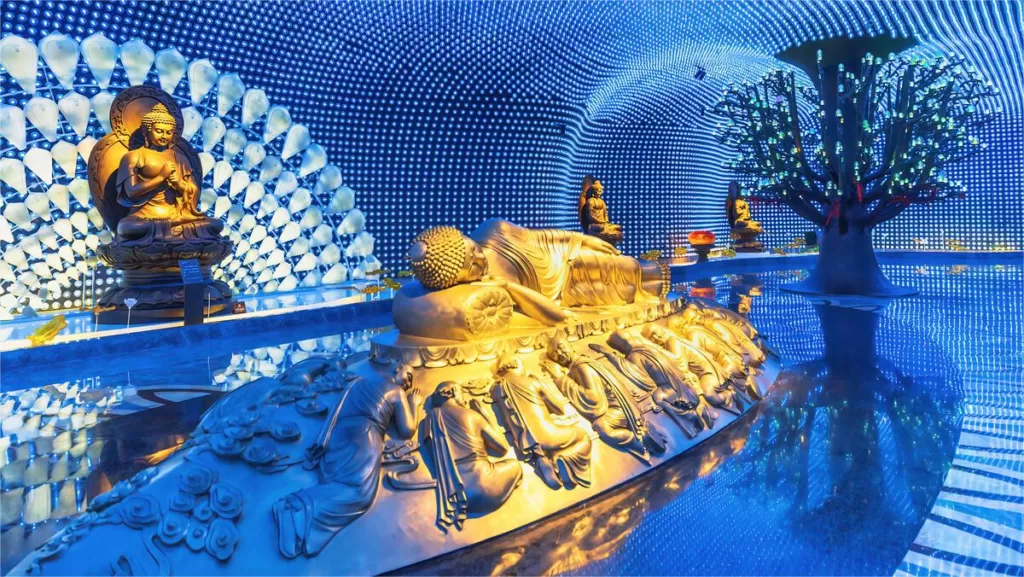Niushou Mountain (牛首山, Bull Head Mountain, Mount Niushou), located within the Niushou Mountain Cultural and Tourist Area in Jiangning District, Nanjing, is a picturesque destination with a unique name and a rich historical and cultural background. The name “Niushou Mountain” is derived from the striking twin peaks at the mountaintop, which resemble the horns of a bull, earning it the local nickname of “Bull’s Head Mountain.”
The historical significance of Niushou Mountain can be traced back to the Eastern Jin Dynasty, during the rule of Emperor Yuan of Jin. It was here that Wang Dao, a prominent statesman and advisor to the emperor, convinced the ruler to abandon the idea of constructing two symbolic towers outside the imperial palace, which were intended to represent the imperial authority. Instead, Wang Dao persuaded Emperor Yuan to take a carriage ride to the south gate of Xuan Yang and gaze at the twin peaks of Niushou Mountain. The sight of these two peaks standing in opposition was deemed a heavenly omen, and Wang Dao suggested that there was no need to build the towers. Hence, Niushou Mountain earned the name “Tianque Mountain,” meaning “Heavenly Towers Mountain.”
The core concept behind the Niushou Mountain Scenic Area is centered on “replenishing the heavenly towers, restoring the sacred path, concealing underground palaces, presenting twin pagodas, developing the Buddhist temple, and promoting culture.” The ultimate goal is to create a world-class cultural heritage site of Buddhism and showcase contemporary architectural art. The scenic area’s design and development aim to rekindle the historical and cultural significance of Niushou Mountain, making it a cultural and architectural gem that preserves the past while embracing the present.
Table of Contents
- Basic Information
- Location and Transportation
- Highlights of Niushou Mountain
- Vlog about Foding Palace
- Useful Tips Summarized from Reviews
- Other Natural Sceneries in Nanjing
- Other Temples in Nanjing
Basic Information
| Website | https://www.niushoushan.net/ |
| Estimated Length of Tour | Over 3 hours |
| Ticket price | 160 RMB |
| Sight-Seeing Bus | 10 RMB |
| Opening Hours | 8.30 – 17.30; Last admission: 16.30 |
| Telephone Number | 0086-4001656363 |
Location and Transportation
Niushou Mountain is situated in the southern part of Nanjing, the capital city of Jiangsu province in China. It is approximately 16 kilometers away from the city center, making it easily accessible for both locals and tourists alike. To get there, you can choose the following ways:
Bus: Take bus 712, 755, or Y2, get off at Niushou Mountain Scenic Area Stop (牛首山风景区站), and you will be standing at the entrance of the mountain.
Metro: Unfortunately, there is no metro station near Niushou Mountain at the moment.
Highlights of Niushou Mountain
Foding Palace

The Foding Palace has served as a revered site for the preservation of Buddhist relics over the years. It spans an impressive length of 220 meters, a width of 160 meters, and reaches a total height of 89.3 meters, encompassing a substantial building area of approximately 136,000 square meters. Its external space is divided into three distinct sections: the grand dome, the smaller dome, and the Foding cliff statues. Internally, the palace consists of nine levels, including three above ground and six underground, featuring the Zen Grand View, the Relic Hall, and the Relic Treasury. Beyond its primary role in safeguarding the relic of the Buddha’s skull and welcoming the devotional visits of believers, the Foding Palace also serves as a cultural exhibition venue, showcasing the rich heritage of relics, global Buddhist traditions, and Zen culture through diverse artistic techniques.
Foding Pagoda

The Foding Pagoda, an exquisite example of Tang-style architecture, stands proudly at a height of 88 meters and occupies an area of 4,677 square meters. It holds a significant place among the revered structures within the Foding Sacred Ground. The pagoda features a remarkable design with nine levels, each facing all four cardinal directions. Notably, the eighth level is home to a magnificent fully copper-cast Vajra bell, known as the Foding Bell, adorned with the complete text of the Diamond Sutra, meticulously inscribed by the renowned monk Longxiang. As one ascends to the ninth level, the tranquil ambiance is enhanced by the presence of a seated statue of Vairocana Buddha, the principal deity enshrined within the Tathagata Hall.
Foding Temple

The history of temples on Niushou Mountain dates back to the early years of the Northern Dynasty. During the Southern Song Dynasty, it was renamed Hongjue Temple. Regrettably, it suffered destruction during the warfare of the Southern Song Dynasty but was later restored during the Ming Dynasty. However, in 1856, the temple faced devastation once again during the Taiping Rebellion, leading to a century-long hiatus in its religious activities. In 2012, a reconstruction project commenced, and by 2015, the temple was fully completed. It was bestowed the name Foding Temple, in honor of the Unisa enshrined in the underground palace of Niushou Mountain. Foding Temple stands as a prominent structure on Niushou Mountain, spanning an area of 68 acres, with a building area of nearly 40 acres. It follows the architectural style reminiscent of the Tang Dynasty, featuring a traditional axial layout.
Zen Grand View

The Zen Grand View is an expansive space that stretches 112 meters from north to south and spans 62 meters from east to west. With an impressive interior height of approximately 41.2 meters, it encompasses three levels above ground. Covering a vast area of over 6,000 square meters, its elliptical shape captivates the eye. The harmonious color palette of yellow, white, and gray masterfully evokes the essence of earthly landscapes, inviting visitors to embark on a Zen-inspired journey as they stroll through. The Zen Grand View consists of three distinctive sections: the Zen Garden, which beautifully portrays the birth and enlightenment of the Buddha, and the central Lotus Theater. Together, they vividly depict the remarkable life journey of the founder of Buddhism.
Relic Hall

The Relic Hall, also known as the Buddha Hall, stands proudly 33 meters above the ground, encompassing the first, second, and third levels of the underground palace. It can be further divided into the Thousand Buddha Hall and the Ten Thousand Buddha Corridor, immersing visitors in a mystical and extraordinary world of Buddhism. Drawing inspiration from the mythical Mount Sumeru, its design incorporates elements from the gilded Seven-Jeweled Stupa of the Great Bao’en Temple and the central pillar of the Mogao Caves in Dunhuang. Symbolizing the purity and magnificence of the Huazang world, the tower spire features a core crystal Muni pearl, representing the samadhi of the Great Sun Tathagata. Below the pearl, an awe-inspiring golden-winged bird, the Garuda, clutches a jeweled necklace in its beak, symbolizing longevity and loyalty.
Vlog about Foding Palace
Useful Tips Summarized from Reviews
Luggage Storage: Both the east and west entrances allow self-service luggage storage, but the west entrance has fewer facilities. If you need assistance, manual luggage storage is available only at the east entrance.
Entrance Time Considerations: If you arrive after 12:00 PM, consider entering through the west entrance. The east entrance tends to be crowded, and there might be queues for the scenic area buses, especially in the afternoon.
Photography Highlights: Capture picturesque moments at several locations, including the water pool in front of the Fo Ding Palace, the small pool on the side of the Fo Ding Palace, the long corridor of the Fo Ding Palace, and the reclining Buddha inside the Fo Ding Palace.
Food and Drink Preparation: Bring some snacks and drinks with you, as there are limited dining options at the mountaintop. Exploring the area can take a couple of hours, and feeling hungry with limited food choices can be uncomfortable. While there are small shops, the food variety might be limited.
Weekend Crowds: Be aware that weekends tend to be crowded, as many tourists visit Nanjing. Niushou Mountain is indeed spectacular, but the crowds can be overwhelming. Plan accordingly and be patient with the crowds.
Performances at Fo Ding Palace: Inside the Fo Ding Palace, there are performances (except on Mondays).
- “Zen Grand View – Lotus Buddha Chanting”: 10:00 and 14:00
- “Thousand Buddha Hall – Passing on the Lamp for Blessings”: 11:00, 12:00, 15:00, and 16:00









